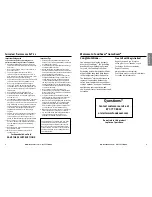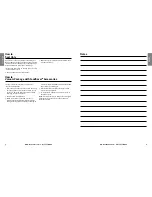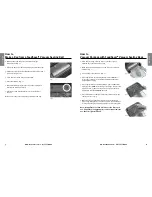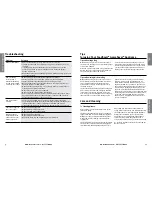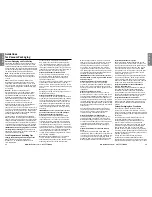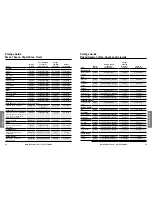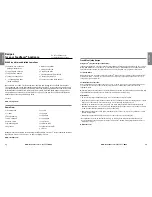
Vacuum Packaging and Food Safety
The vacuum packaging process extends the life of
foods by removing most of the air from the sealed
container, thereby reducing oxidation, which affects
nutritional value, flavor and overall quality. Removing
air can also inhibit growth of microorganisms, which
can cause problems under certain conditions:
Mold
– Easily identified by its fuzzy characteristic.
Mold cannot grow in a low oxygen environment,
therefore vacuum packaging can slow the growth
of mold.
Yeast
– Results in fermentation, which can be
identified by smell and taste. Yeast needs water,
sugar and a moderate temperature to grow. It can
also survive with or without air. Slowing the growth
of yeast requires refrigeration, while freezing stops
it completely.
Bacteria
– Results in an unpleasant odor,
discoloration and/or soft or slimy texture. Under
the right conditions, anaerobic bacteria such as
Clostridium botulinum (the organism that causes
Botulism) can grow without air and sometimes
cannot be detected by smell or taste. Although it is
extremely rare, it can be very dangerous.
To preserve foods safely, it is critical that you
maintain low temperatures. You can significantly
reduce the growth of microorganisms at
temperatures of 40°F (4°C) or below. Freezing at 0°F
(-17°C) does not kill microorganisms, but stops them
from growing. For long-term storage, always freeze
perishable foods that have been vacuum packaged,
and keep refrigerated after thawing.
It is important to note that vacuum packaging is
NOT a substitute for canning and it cannot reverse
the dete rio ration of foods. It can only slow down the
changes in quality. It is difficult to predict how long
foods will retain their top-quality flavor, appearance
or texture because it depends on age and condition
of the food on the day it was vacuumed packaged.
IMPORTANT: Vacuum packaging is NOT a substitute
for refrigeration or freezing.
Any perishable foods
that require refrigeration must still be refrigerated or
frozen after vacuum packaging.
Food Preparation and Reheating Tips
Thawing and Reheating Vacuum Packaged Foods
Always thaw foods in either refrigerator or
microwave — do not thaw perishable foods at
room temperature.
To reheat foods in a microwave in a FoodSaver
®
Bag, always cut corner of the bag before placing
it on a microwave-safe dish. However, to avoid hot
spots, do not reheat bone-in meat or greasy foods
in microwave within a FoodSaver
®
Bag. You can also
reheat foods in FoodSaver
®
Bags by placing them in
water at a low simmer below 170°F (75°C).
Preparation Guidelines for Meat and Fish:
For best results, pre-freeze meat and fish for 1–2
hours before vacuum packaging in a FoodSaver
®
Bag. This helps retain the juice and shape, and
guarantees a better seal.
If it’s not possible to pre-freeze, place a folded paper
towel between meat or fish and top of bag, but
below seal area. Leave paper towel in bag to absorb
excess moisture and juices during vacuum packaging
process.
Note:
Beef may appear darker after vacuum
packaging due to the removal of oxygen. This is not
an indication of spoilage.
Preparation Guidelines for Hard Cheeses:
To keep cheese fresh, vacuum package it after each
use. Make your FoodSaver
®
Bag extra long, allowing
one inch of bag material for each time you plan to
open and reseal in addition to the 3-inch room you
normally leave between contents and seal. Simply
cut sealed edge and remove cheese. When you’re
ready to repackage the cheese, just drop it in bag
and reseal.
IMPORTANT: Due to the risk of anaerobic bacteria,
Soft cheeses should never be vacuum packaged.
Preparation Guidelines for Vegetables:
Vegetables need to be blanched before vacuum
packaging. This process stops the enzyme action
that could lead to loss of flavor, color and texture.
To blanch vegetables, place them in boiling water
or in the microwave until they are cooked, but still
crisp. Blanching times range from 1 to 2 minutes for
leafy greens and peas; 3 to 4 minutes for snap peas,
sliced zucchini or broccoli; 5 minutes for carrots; and
7 to 11 minutes for corn on the cob. After blanching,
immerse vegetables in cold water to stop the
cooking process. Finally, dry vegetables on a towel
before vacuum packaging.
Note:
All vegetables (including broccoli, brussels
sprouts, cabbage, cauliflower, kale, turnips)
naturally emit gases during storage. Therefore, after
blanching, they must be stored in freezer only.
Guidelines
for Vacuum Packaging
When freezing vegetables, it is best to pre-freeze
them for 1–2 hours or until solidly frozen. To freeze
vegetables in individual servings, first place on
a baking sheet and spread them out so they are
not touching. This prevents them from freezing
together in a block. Once they are frozen, remove
from baking sheet and vacuum package vegetables
in a FoodSaver
®
Bag. After they have been vacuum
packaged, return them to the freezer.
IMPORTANT: Due to the risk of anaerobic bacteria,
Fresh mushrooms, onions, & garlic should never be
vacuum packaged
.
Preparation Guidelines for Leafy Vegetables:
For best results, use a canister to store leafy
vegetables. First wash the vegetables, and then dry
with a towel or salad spinner. After they are dried,
put them in a canister and vacuum package. Store in
refrigerator.
Preparation Guidelines for Fruits:
When freezing soft fruits or berries, it is best to
pre-freeze them for 1–2 hours or until solidly frozen.
To freeze fruit in individual servings, first place on a
baking sheet and spread them out so they are not
touching. This prevents them from freezing together
in a block. Once they are frozen, remove from baking
sheet and vacuum package fruit in a FoodSaver
®
Bag.
After they have been vacuum packaged, return them
to the freezer.
You can vacuum package portions for baking, or
in your favorite combinations for easy fruit salad
all year round. If storing in the refrigerator, we
recommend using a FoodSaver
®
Canister.
Preparation Guidelines for Baked Goods:
To vacuum package soft or airy baked goods, we
recommend using a FoodSaver
®
Canister so they
will hold their shape. If using a bag, pre-freeze for
1–2 hours or until solidly frozen. To save time, make
cookie dough, pie shells, whole pies, or mix dry
ingredients in advance and vacuum package for
later use.
Preparation Guidelines for Coffee and Powdery
Foods:
To prevent food particles from being drawn into
vacuum pump, place a coffee filter or paper towel at
top of bag or canister before vacuum packaging. You
can also place the food in its original bag inside a
FoodSaver
®
Bag, or use a FoodSaver
®
Universal Lid
with the original container to vacuum package.
Preparation Guidelines for Liquids:
Before you vacuum package liquids such as soup
stock, pre-freeze in a casserole dish, loaf pan or ice
cube tray until solid. Remove frozen liquid from pan
and vacuum package in a FoodSaver
®
Bag. You can
stack these “frozen bricks” in your freezer. When
you’re ready to use, just cut corner of bag and place
in a dish in microwave or drop into water at a low
simmer, below 170°F (75°C).
To vacuum package non-carbonated bottled liquids,
you can use a FoodSaver
®
Bottle Stopper with the
original container. Remember to leave at least one
inch of room between contents and bottom of Bottle
Stopper. You can re-seal bottles after each use.
Preparation Guidelines for Make-ahead Meals,
Leftovers and Sandwiches:
Efficiently store your make-ahead meals, leftovers
and sandwiches in the stackable, lightweight
FoodSaver
®
containers. They are microwaveable,
top rack dishwasher safe and come with a custom
adaptor. The lightweight containers will be ready to
head off to the office or school when you are!
Preparation Guidelines for Snack Foods:
Your snack foods will maintain their freshness longer
when you vacuum package them. For best results,
use a FoodSaver
®
Canister for crushable items like
crackers.
Vacuum Packaging Non-Food Items
The FoodSaver
®
vacuum packaging system also
protects non-food items from oxidation, corrosion
and moisture. Simply follow the directions to vacuum
package items using FoodSaver
®
Bags, Canisters and
Accessories.
To vacuum package silver, wrap fork tines in soft
cushioning material, such as a paper towel, to
avoid puncturing bag. Your FoodSaver
®
Bags are
ideal for outdoor excursions. For camping and
hiking, keep your matches, maps and food dry and
compact. To have fresh water for drinking, simply
fill a FoodSaver
®
Bag with ice, seal it and when
needed, let the ice pack melt. If you’re going sailing
or boating, vacuum package your food, film and a dry
change of clothes. Just remember to bring scissors or
a knife to open the bag.
To keep emergency kits safe and dry, vacuum
package flares, batteries, flashlights, matches,
candles and other necessities. Your emergency items
will stay dry and organized in your home, car or boat.
G
U
IDE
LIN
ES
G
U
IDE
LI
N
ES
www.foodsaver.com
1-877-777-8042
www.foodsaver.com
1-877-777-8042
11
12


